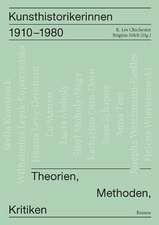Transformative Jars: Asian Ceramic Vessels as Transcultural Enclosures: Material Culture of Art and Design
Editat de Anna Grasskamp, Dr Anne Gerritsenen Limba Engleză Paperback – 26 iun 2024
| Toate formatele și edițiile | Preț | Express |
|---|---|---|
| Paperback (1) | 193.62 lei 43-57 zile | |
| Bloomsbury Publishing – 26 iun 2024 | 193.62 lei 43-57 zile | |
| Hardback (1) | 514.82 lei 22-36 zile | |
| Bloomsbury Publishing – 28 dec 2022 | 514.82 lei 22-36 zile |
Din seria Material Culture of Art and Design
- 22%
 Preț: 171.34 lei
Preț: 171.34 lei - 23%
 Preț: 192.48 lei
Preț: 192.48 lei - 22%
 Preț: 167.97 lei
Preț: 167.97 lei - 20%
 Preț: 204.41 lei
Preț: 204.41 lei - 23%
 Preț: 193.07 lei
Preț: 193.07 lei - 12%
 Preț: 180.52 lei
Preț: 180.52 lei - 21%
 Preț: 171.59 lei
Preț: 171.59 lei - 21%
 Preț: 171.69 lei
Preț: 171.69 lei - 7%
 Preț: 149.90 lei
Preț: 149.90 lei - 30%
 Preț: 543.25 lei
Preț: 543.25 lei - 30%
 Preț: 545.69 lei
Preț: 545.69 lei - 30%
 Preț: 544.88 lei
Preț: 544.88 lei - 30%
 Preț: 538.77 lei
Preț: 538.77 lei - 30%
 Preț: 542.35 lei
Preț: 542.35 lei - 30%
 Preț: 542.35 lei
Preț: 542.35 lei - 23%
 Preț: 192.82 lei
Preț: 192.82 lei - 6%
 Preț: 139.82 lei
Preț: 139.82 lei - 13%
 Preț: 174.07 lei
Preț: 174.07 lei - 23%
 Preț: 200.36 lei
Preț: 200.36 lei - 22%
 Preț: 233.37 lei
Preț: 233.37 lei - 30%
 Preț: 778.29 lei
Preț: 778.29 lei - 21%
 Preț: 216.88 lei
Preț: 216.88 lei -
 Preț: 250.59 lei
Preț: 250.59 lei
Preț: 193.62 lei
Preț vechi: 250.59 lei
-23% Nou
Puncte Express: 290
Preț estimativ în valută:
37.06€ • 40.27$ • 31.15£
37.06€ • 40.27$ • 31.15£
Carte tipărită la comandă
Livrare economică 21 aprilie-05 mai
Preluare comenzi: 021 569.72.76
Specificații
ISBN-13: 9781350277472
ISBN-10: 1350277479
Pagini: 296
Ilustrații: 28 colour & 40 bw illus
Dimensiuni: 156 x 234 x 25 mm
Greutate: 0.45 kg
Editura: Bloomsbury Publishing
Colecția Bloomsbury Visual Arts
Seria Material Culture of Art and Design
Locul publicării:London, United Kingdom
ISBN-10: 1350277479
Pagini: 296
Ilustrații: 28 colour & 40 bw illus
Dimensiuni: 156 x 234 x 25 mm
Greutate: 0.45 kg
Editura: Bloomsbury Publishing
Colecția Bloomsbury Visual Arts
Seria Material Culture of Art and Design
Locul publicării:London, United Kingdom
Caracteristici
Brings contemporary examples of art that use jars into dialogue with everyday household ceramics and urns in order to explore the relationship between art and material culture in all of its complexity
Notă biografică
Anna Grasskamp is Lecturer at the School of Art History at University of St Andrews, UK. She is the author of Objects in Frames: Displaying Foreign Collectibles in Early Modern China and Europe (2019) and Art and Ocean Objects of Early Modern Eurasia: Shells, Bodies, and Materiality (2021).Anne Gerritsen is Professor of History at the University of Warwick, UK, and Chair of Asian Art at University of Leiden, Netherlands. She is the author of Ji'an Literati and the Local (2007), and The City of Blue and White: Chinese Porcelain and the Early Modern World (2020). At Warwick, she co-directs the Global History and Culture Centre.
Cuprins
List of ContributorsList of IllustrationsTransformative Jars: An Introduction Anna Grasskamp, University of St Andrews, UK; Anne Gerritsen, University of Warwick, UK, and Leiden University, NetherlandsPart I. Transformative Matters: Ceramic Vessels, Chemistry and Socio-Economic Change Chapter 1. Dreams of Transformation: A 14th-century Flask from Cizhou Anne Gerritsen, University of Warwick and Leiden UniversityChapter 2. Jars that Cheered: Alcohol and Stoneware Containers in Java before 1500 Jiri Jakl, University of HeidelbergPart II. Transformative Spaces: Ceramic Vessels and Asian Locations Chapter 3. Siamese Jars and their Significance in Southeast-Asian Trade from the 14th to the 18th CenturyAtthasit Sukkham, Bangkok UniversityChapter 4. Weaving Networks: Production and Exchange of Ceramic Jars in South China and Vietnam from the 14th to the 16th CenturyWong Wai-yee Sharon, Chinese University of Hong KongPart III. Transcultural Enclosures: Containers and their Contents in Global Context Chapter 5. For Oil, Date Syrup and the Tomb of a Chinese Queen: The Reciprocal Trade in Chinese and West Asian Jars in the Late Tang/Early Abbasid PeriodsEva Ströber, Curator Emerita, National Museum of Ceramics Princessehof Leeuwarden Chapter 6. Translocation and Transformation: The Lives of Chinese Fishbowls in the Early Modern Period Wen-ting Wu, National Taiwan UniversityPart IV. Transformative Containers: Individual Jars and Modes of AgencyChapter 7. The Jars Have Ears: Circulation and Proliferation of Chinese Prototype Container Jars and their Offspring in Asia Louise Cort, Curator Emerita for Ceramics, Freer Gallery of Art and Arthur M. Sackler Gallery, Smithsonian InstitutionChapter 8. Dragons in Flux: A Changing Relationship between People and Jars in the Kelabit Highlands, Borneo, from the 19th to the 21st centuryBorbala Nyiri, independent scholarChapter 9. Jar Interventions: Ceramic Containers as Disobedient Objects in Contemporary Asian Art Sooyoung Leam, The Courtauld Institute of Art, UK; Anna Grasskamp, University of St Andrews, UKChapter 10. Concluding Thoughts on Transformative Jars: Asian Ceramic Vessels as Transcultural Enclosures Anna Grasskamp, University of St Andrews, UK; Anne Gerritsen, University of Warwick, UK, and Leiden University, NetherlandsIndex
Recenzii
This fascinating, multidisciplinary collection of essays on ceramic jars from, and in, global contexts illuminates ceramic trade, consumption, production and reception through the lens of a single form, demonstrating the agency of vessels as both containers and cultural objects.
A brainstorm of a book, with scholars from a wide range of different fields, Transformative Jars gathers fresh studies on Asian ceramics. It not only totally reshapes our ideas on these most common and practical vessels but also greatly contributes to the interdisciplinary nature of material culturestudies.
A brainstorm of a book, with scholars from a wide range of different fields, Transformative Jars gathers fresh studies on Asian ceramics. It not only totally reshapes our ideas on these most common and practical vessels but also greatly contributes to the interdisciplinary nature of material culturestudies.



















